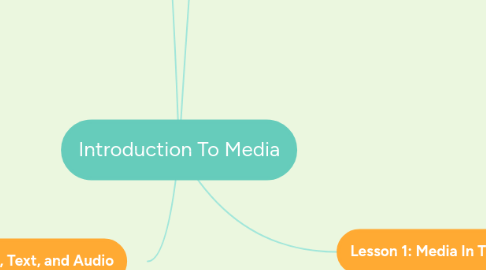
1. Lesson 2: Understanding Media; Aesthetics of the Image, Text, and Audio
1.1. Framing and Reading
1.1.1. Newspapers and Journalism
1.1.2. Books, Comics, Magazines, and the Publishing Industry
1.1.3. Photography and Timeless Image Concepts
1.2. Framing and Listening
1.2.1. Radio and Evoking Imagination
2. Lesson 4: Understanding Media; Aesthetics of New Media and Social Media
2.1. Deconstructing New Media
2.1.1. New Media Technology: Convergence and Characteristics
2.1.2. New Media as Multimedia
2.1.3. New Media Transitions: From Synergy to Transmedia
2.1.4. Transitioning Media, Transitioning Users
2.2. Deconstructing Social Media
2.2.1. What is Social Networking
2.2.2. Kinds of Social Media and its Varying Uses
2.2.2.1. Print-based
2.2.2.2. Audio-based
2.2.2.3. Photo-based
2.2.2.4. Video-based
2.2.2.5. Social Networking Sites
2.2.2.6. Call and Chat-based
2.2.3. Relevance of Social Media in Today's Society
2.2.3.1. Personal Communications
2.2.3.2. Business and Customer Care Tools
2.2.3.3. Social Services and Governance
2.2.3.4. Educational tools
2.2.3.5. Advocacy Campgains for Social Change
2.2.3.6. Traditional Media Coverage and Social Media Enhancement
2.2.3.7. Enterntainment Portals
2.3. Intersecting Traditional Media, New Media, and Social Media Networking
2.3.1. Journalism + Internet
2.3.1.1. Blogging
2.3.2. Broadcasting + Internet
2.3.2.1. Podcast
2.3.3. Film + Internet
2.3.3.1. YouTube
2.3.4. TV + Internet
2.3.4.1. Steaming Media
2.3.5. Advertising + Social Media
2.3.5.1. Social Media Influencers
3. Lesson 1: Media In The Context Of MIL
3.1. What to Expect in Your MIL Course -Learning about the nature of media in relation to the other fields -Learning about how to be literate when we deal with various media channels
3.1.1. MIL Thematic Coverage
3.1.1.1. Differentiating Media Literacy (MIL) and Information Literacy
3.1.1.2. Media and Information Sources
3.1.1.3. Media and Information Languages
3.1.1.4. Literacies of the 21st Century
3.1.2. UNESCO Five Laws of Media Literacy
3.1.2.1. Law 1: Information, communication libraries, media, technology, the Internet as well as the other forms of information providers are for use in critical civic engagement and sustainable development
3.1.2.2. Law 2: MILis for all- women and men equally- and a nexus of human rights
3.1.2.3. Law 3: Information, knowledge, and messages are not always value neutral or always indipendent of biases
3.1.2.4. Law 4: Every citizen wants to know and understand new information. Her/his rights must however never be compromised
3.1.2.5. Law 5: Media and Information literacy is not acquired at once
3.1.3. The Path to Becoming a Media and Information Literate Individual
3.1.3.1. Having an improved quality of life
3.1.3.2. Having greater political participation
3.1.3.3. Having better economic opportunities
3.1.3.4. Creating an improved learning environment
3.1.3.5. Developing more cohesive social units
3.1.4. Debunking Media Literacy Myths
3.1.4.1. Critizising is not the same as being cynical of the media
3.1.4.2. Everybody needs to be media literate
3.1.4.3. Media technologies are evolving in leaps and bounds lately
3.1.5. Text, Context, and Subtext
3.1.5.1. Media and Information Literacy will help us understand the value of being a media and information literate individual currently inhabiting the knowledge society
3.1.5.2. It will be like a guideline for us whenever we encounter media products along the way
3.2. Deconstructing Media -Media is present in your daily life
3.2.1. From Information to Communication -Informatoin is spreaded whenever an information is told. In short, it has a domino effect. This is also how the communication process work
3.2.1.1. The Communication Process
3.2.1.2. The Feedback Mechanism
3.2.1.3. Mass Media and Mass Communication
3.2.1.4. Media as an information Industry
3.2.1.5. Media as a Culture of Enterntainment
3.3. Types of Media
3.3.1. Traditional Media
3.3.2. New Media
3.3.2.1. Social Media
3.3.2.2. Mobile Communications Technology
3.4. Current and Future Trends of media and Information
3.4.1. Massive Open Online Courses (MOOCs)
3.4.2. Wearable Technology
3.4.3. 3-D Environment
3.4.4. Ubiquitous Learning
3.4.5. Other Related and Emerging Technologies on Media Convergence
3.4.5.1. Gaming Technologies
3.4.5.2. Virtual Reality
3.4.5.3. Augmented Reality
3.4.5.4. 360-degree Photo/Video
3.4.5.5. Mixed Reality
3.5. The Evolution of Traditional Media to New Media
3.5.1. Prehistoric Age
3.5.2. Industrial Age
3.5.3. Electronic Age
3.5.4. New Information/Digital Age
3.6. Brief History of Philippine Media
3.6.1. Precolonial Traces
3.6.2. The Print Industry and Filipino Freedom
3.6.3. The European Film Import
3.6.4. The Broadcast Industry
3.6.5. Local Online Media
4. Lesson 3: Understanding Media; Aestethics of Film and TV
4.1. The Film Form
4.1.1. Modes of Film Production
4.1.2. Film Formats
4.1.2.1. Narrative
4.1.2.2. Documentary
4.1.2.3. Animation
4.1.2.4. Experimental
4.1.3. Film Image Composition
4.1.4. Motion Framing Concepts
4.2. The TV Broadcast
4.2.1. Kinds of TV Shows
4.2.1.1. Informative Programming
4.2.1.2. Enterntainment Programming
4.2.2. TV Show Anatomy and Advertising
4.3. Crafting Audiovisual Media Messages
4.3.1. Creating Meaning in Audio Production
4.3.2. Creating Meaning in Image Production
4.3.3. Creating Meaning in Audiovisual Production
